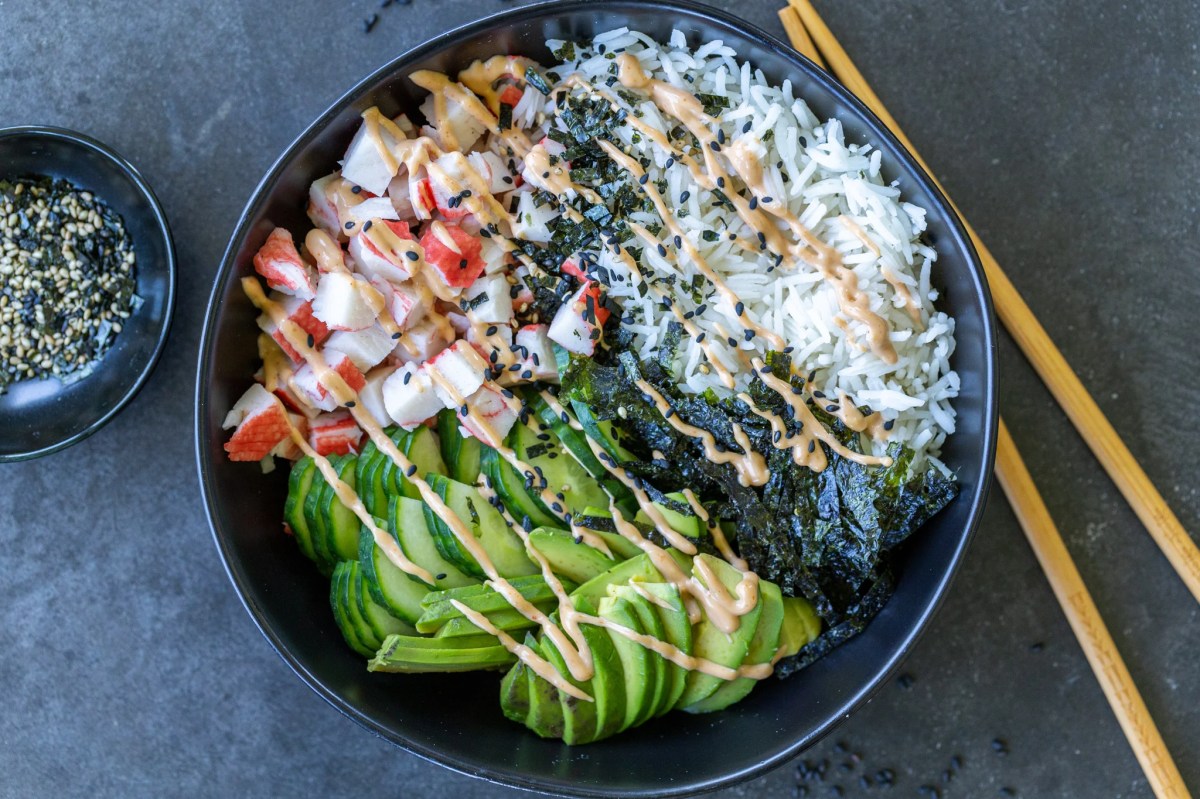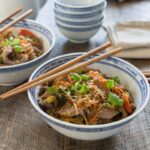Craving sushi but committed to a Paleo lifestyle? Imagine vibrant, colorful bowls brimming with fresh, nutrient-rich ingredients, bursting with flavor and texture. Forget the rice; we’re diving into the art of creating delicious and healthy Paleo sushi bowls, packed with protein, crisp vegetables, and tantalizing sauces. This guide will equip you with the knowledge and recipes to craft stunning, satisfying meals that are both paleo-friendly and visually captivating.
We’ll explore a range of paleo-approved ingredients, from succulent proteins like salmon and chicken to vibrant vegetables and cauliflower rice, a fantastic grain-free base. Learn to master the art of preparing cauliflower rice, achieving the perfect texture and taste. Discover three unique sauce options that will elevate your bowl to culinary heights. Finally, we’ll uncover the secrets to creating visually stunning presentations that will impress even the most discerning palate.
Preparing Paleo-Friendly Sushi Rice Alternatives
Creating a delicious and authentic-feeling sushi bowl while adhering to a paleo diet requires a clever substitution for traditional rice. Cauliflower rice is a popular and versatile choice, offering a light, fluffy texture that readily absorbs flavors. This section details various methods for preparing cauliflower rice, highlighting their unique characteristics.
Cauliflower Rice Preparation Methods
Three distinct methods yield varying textures and tastes in cauliflower rice. The choice depends on personal preference and the desired outcome for your sushi bowl. Each method begins with a head of fresh cauliflower, thoroughly washed and cut into florets.
- Food Processor Method: This method produces a finer, more rice-like texture. Simply pulse the cauliflower florets in a food processor until they resemble small, granular pieces. Avoid over-processing, as this can lead to a mushy consistency. The resulting cauliflower rice is nearly indistinguishable from the real thing in texture and appearance. It’s ideal for those seeking a close imitation of traditional sushi rice.
- Grater Method: Using a box grater, grate the cauliflower florets into a bowl. This method produces a slightly coarser texture than the food processor method, with some larger pieces of cauliflower remaining. This texture is slightly more substantial and holds its shape better, making it suitable for sushi bowls where you want a bit more “bite”. The appearance is more visibly cauliflower-like, but still integrates well within the bowl.
- Knife Method: For the most rustic texture, finely chop the cauliflower florets with a sharp knife. This requires more time and effort but allows for greater control over the size and shape of the “rice”. The resulting texture is noticeably chunkier, offering a pleasing contrast in your sushi bowl. This method is best for those who appreciate a more pronounced cauliflower flavor and texture.
Ideal Texture and Appearance of Prepared Cauliflower Rice
Imagine a bowl of pristine white cauliflower rice. Using any of the above methods, the ideal texture should be light and airy, not soggy or mushy. The individual pieces should be small enough to mimic the grain of rice, but still retain a slight firmness to avoid a pasty mouthfeel. The color should be a bright, almost translucent white, indicating freshness and proper preparation. Avoid any browning or discoloration, which suggests over-processing or cooking. The overall appearance should be visually appealing, complementing the vibrant colors of the other ingredients in your paleo sushi bowl. The texture should be pleasantly firm, yet tender enough to easily absorb the flavors of the sauces and other components of your sushi bowl.
Constructing the Paleo Sushi Bowls

Creating a paleo sushi bowl is a delightful culinary adventure, allowing for vibrant colors and exciting flavor combinations while adhering to paleo principles. The key lies in careful layering and ingredient selection to achieve both visual appeal and a harmonious blend of tastes and textures. This step-by-step guide will walk you through the process, ensuring your creation is as delicious as it is beautiful.
Layering the Paleo Sushi Bowl for Optimal Presentation
The order in which you layer your ingredients significantly impacts the overall presentation and eating experience of your paleo sushi bowl. A well-constructed bowl is visually appealing and ensures each bite offers a balanced mix of flavors and textures. We recommend starting with the base and building upwards.
- Base Layer: Cauliflower Rice or Zucchini Noodles: Begin by placing a generous bed of your chosen paleo rice alternative in the bowl. Imagine a soft, fluffy cloud of cauliflower rice, lightly seasoned with sea salt and a touch of coconut aminos, forming the foundation of your culinary masterpiece. Alternatively, a nest of vibrant green zucchini noodles provides a refreshing and slightly more substantial base.
- Protein Layer: Sushi-Grade Salmon or Chicken: Next, arrange your protein source artfully atop the base. Picture slices of rich, vibrant orange sushi-grade salmon, glistening with a light drizzle of sesame oil, delicately placed across the bowl. For a lighter option, tender pieces of grilled chicken breast, seasoned simply with herbs and spices, provide a satisfying protein boost.
- Vegetable Layer: A Rainbow of Freshness: Now, add a colorful array of finely sliced or julienned vegetables. Envision thinly sliced avocado, its creamy green flesh contrasting beautifully with the bright orange carrots and the deep crimson of thinly sliced red bell pepper. A sprinkle of finely chopped edamame adds a pop of green and a touch of nutty flavor.
- Topping Layer: A Symphony of Flavors and Textures: Finish with your chosen toppings to add textural contrast and a burst of flavor. Consider a scattering of toasted sesame seeds, their nutty aroma complementing the other ingredients. A drizzle of a vibrant, tangy paleo-friendly sauce, such as a coconut aminos-based dressing, adds a finishing touch, binding the elements together in a harmonious blend.
Ingredient Substitutions for Dietary Needs and Preferences
While this recipe provides a delicious and visually stunning paleo sushi bowl, adjustments can be made to accommodate various dietary needs and preferences, always maintaining paleo principles.
- Protein Alternatives: Instead of salmon or chicken, consider using thinly sliced beef, cooked shrimp, or even sustainably sourced tuna. Each offers a unique flavor profile and texture.
- Vegetable Variations: Feel free to substitute your preferred vegetables. Think vibrant purple cabbage, crisp cucumber, or even finely shredded daikon radish for a spicy kick. The possibilities are endless!
- Sauce Alternatives: Experiment with different paleo-friendly sauces to complement your chosen ingredients. A creamy avocado dressing, a zesty lime dressing, or even a simple drizzle of olive oil and herbs can enhance the flavors.
- Nut-Free Options: For those with nut allergies, substitute sesame seeds with sunflower seeds or pumpkin seeds for a similar textural element.
Creating Paleo sushi bowls is more than just assembling ingredients; it’s an opportunity to unleash your creativity and craft a truly personalized culinary experience. From the careful selection of vibrant vegetables and protein to the masterful preparation of cauliflower rice and the choice of a perfectly complementing sauce, each element contributes to a symphony of flavors and textures. With this guide, you’re not just making a meal; you’re creating a work of edible art, a testament to the delicious possibilities of a healthy and fulfilling Paleo lifestyle. Experiment, innovate, and enjoy the journey of discovering your perfect Paleo sushi bowl.
Answers to Common Questions
Can I use other vegetables besides those listed?
Absolutely! Feel free to experiment with other paleo-friendly vegetables like bell peppers, cucumbers, shredded carrots, or spinach.
How long can I store leftover Paleo sushi bowls?
Store leftovers in an airtight container in the refrigerator for up to 3 days. The cauliflower rice may absorb some moisture over time.
Are there any potential allergens in these recipes?
Always check ingredient labels to ensure they align with your specific dietary needs and allergies. Common allergens like soy (in some sauces) should be considered.
Can I make the bowls ahead of time?
You can prepare the cauliflower rice and sauces in advance. Assemble the bowls just before serving for optimal freshness and texture.


